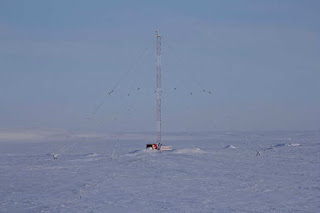 Hunting For NDBs In CLE 203
Hunting For NDBs In CLE 203
 |
| RB-350kHz - courtesy: http://www.ve3gop.com/pict.htm |
This coming weekend will see another CLE challenge, this time in the 20 kHz slice from 350.0 - 369.9 kHz.
A nice catch for North American listeners, as well as for over-the-pole Europeans, is 'RB' - 350kHz, in Resolute By, Nunavut. Its big 3,000-watt signal has been heard all over Europe and in NA from Hawaii to New England. If you haven't participated in one of the monthly CLE activities before, this midwinter event might be just the right time to get started ... the low geomagnetic activity of late looks very encouraging.
From CLE coordinator Brian Keyte (G3SIA), comes the following reminder:
Hi all:
No Specials - just an ordinary Listening Event is only a week away:
Days: Friday 22 January - Monday 25 January
Times: Start and End at midday, your LOCAL time
Range: 350.0 - 369.9 kHz
Just log the NDBs that you can identify having their nominal (published)
frequencies in that range, plus any UNIDs that you come across there.
We last concentrated on these frequencies during CLE186 in Sept 2014.
Please send your CLE log to the List (no attachments and ideally in a
plain text email) with CLE203 at the start of its title. Show on each line:
# The Date (or Day No: 27 to 30)
# The Time in UTC
# kHz - the nominal published frequency, if known.
# The Call Ident.
Please show those main items FIRST. Any other optional details such
as Location and Distance go LATER in the same line.
If you send any interim logs, please also send a 'Final' (complete) one.
And, of course, tell us your own location and brief details of the
equipment that you were using during the Event.
You can find full details about current and past CLEs from the CLE page
http://www.ndblist.info/cle.htm including access to the CLE203 seeklists (soon) for your part of the World prepared from the loggings on Rxx.
Good listening - enjoy the CLE.
Brian
----------------------------------------------------------
From: Brian Keyte G3SIA: <ndbcle'at'gmail.com>
Location: Surrey, SE England (CLE co-ordinator)
----------------------------------------------------------
(If you would like to listen remotely you could use any one remote
receiver such as http://websdr.ewi.utwente.nl:8901/ for your
loggings, stating its location and owner and with their permission
if required. A remote listener may NOT also use another receiver,
local or remote, to make further loggings for the same CLE)
__._,_.___
These listening events serve several purposes. They:
- determine, worldwide, which beacons are actually in service and on-the-air so the online database can be kept up-to-date
- determine, worldwide, which beacons are out-of-service or have gone silent since the last CLE covering this range
- will indicate the state of propagation conditions at the various participant locations
- will give you an indication of how well your LF/MF receiving system is working
- give participants a fun yet challenging activity to keep their listening skills honed
Final details can be found at the NDB List website, and worldwide results, for every participant, will be posted there a few days after the event. If you are a member of the ndblist Group, results will also be e-mailed and posted there.
The very active Yahoo ndblist Group is a great place to learn more about the 'Art of NDB DXing' or to meet other listeners in your region. There is a lot of good information available there and new members are always very welcome.
If you are contemplating getting started on 630m, listening for NDBs is an excellent way to test out your receive capabilities as there are several NDBs located near this part of the spectrum.
You need not be an ndblist member to participate in the CLEs and all reports, no matter how small, are of much value to the organizers. 'First-time' logs are always VERY welcome!
Reports may be sent to the ndblist or e-mailed to either myself or CLE co- ordinator, Brian Keyte (G3SIA), whose address appears above.
Please ... give the CLE a try ... then let us know what NDB's can be heard from your location! Your report can then be added to the worldwide database to help keep it up-to-date.
__._,_.___














Note that this line:
# The Date (or Day No: 27 to 30)
should read:
# The Date (or Day No: 22 to 25)
Sorry for any confusion.